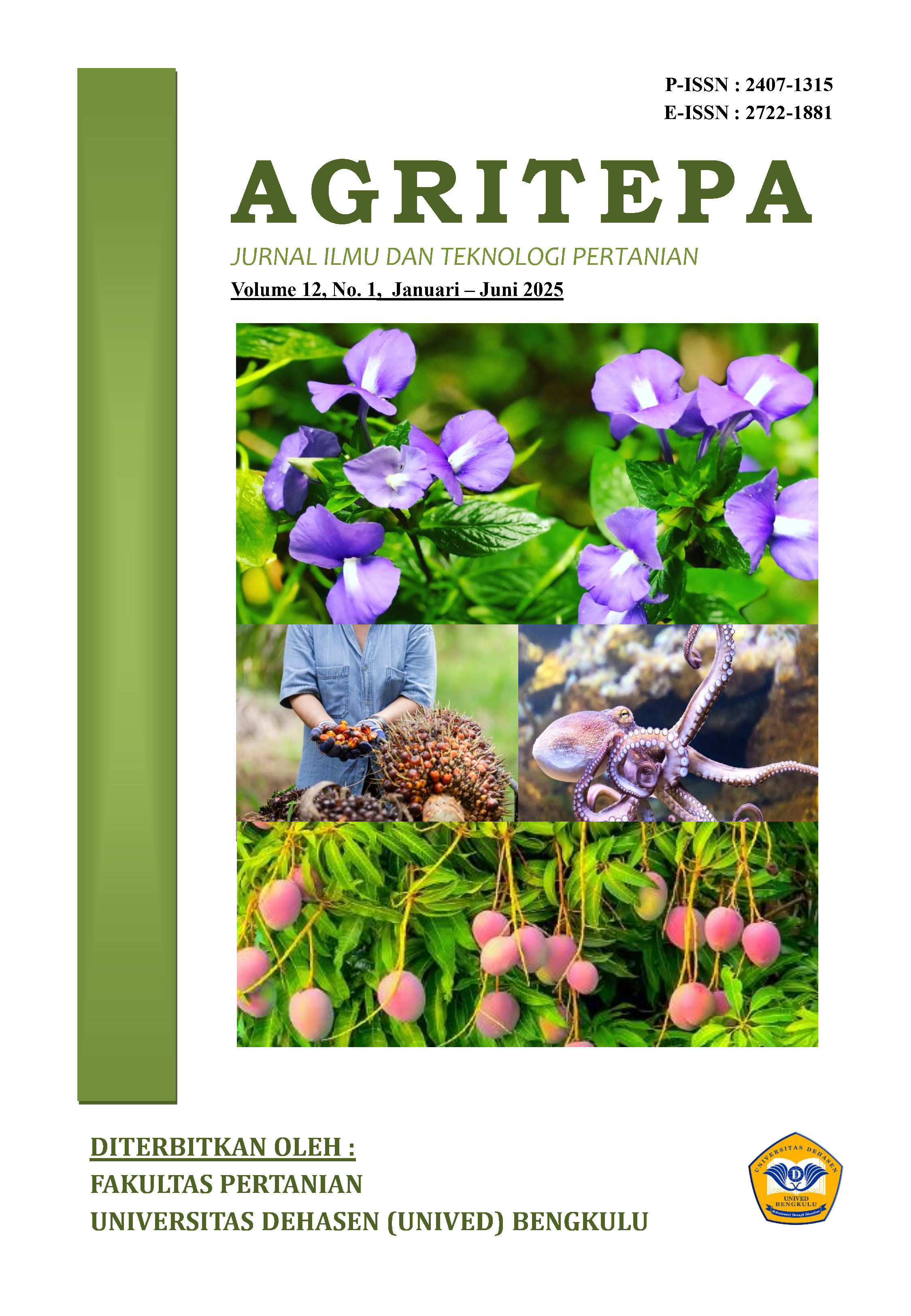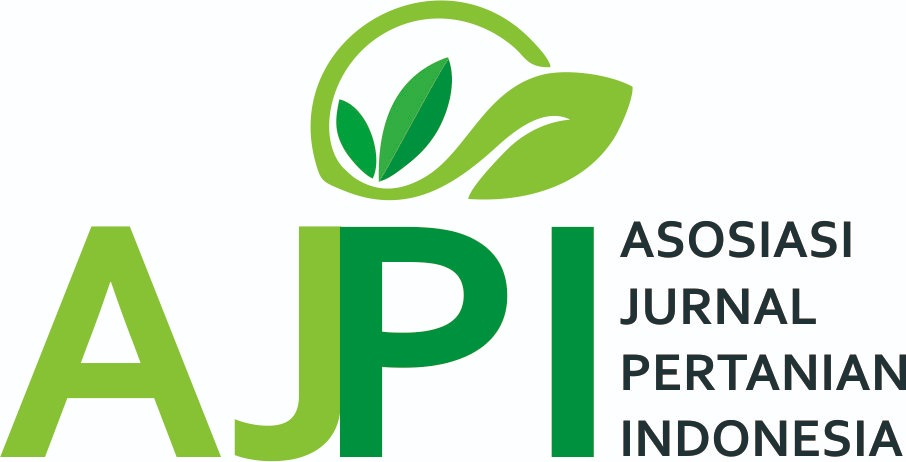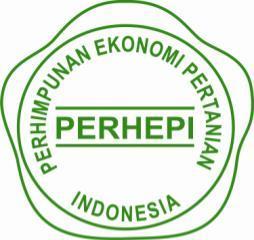Effectiveness Of Various Active Ingredients In Controlling Anthracnose Fungi In Post-Harvest Mango (Mangifera Indica L.)
Abstract
The Purpose : This study aimed to evaluate the effectiveness of various active ingredients in controlling anthracnose (Colletotrichum gloeosporioides) on postharvest mangoes (Mangifera indica L.). Anthracnose is a key postharvest disease that affects fruit quality and shelf life. Methodology : A Completely Randomized Design (CRD) was applied with five treatments : control, azoxystrobin + difenoconazole, mancozeb 75%, mancozeb + carbendazim, and propineb 70%, each replicated five times. Parameters included time of fungal emergence and the extent of fungal spread during storage. Results : The combination of azoxystrobin and difenoconazole significantly delayed fungal emergence to an average of 7.4 days and reduced the spread score to 1.8 on a 1–5 scale. Findings : This treatment exhibited superior efficacy compared to others, highlighting the synergistic effect of dual-action fungicides. Novelty : The research introduces the use of dual-mode fungicide combinations as a novel approach for postharvest disease management in mangoes. Originality : This study presents original data supporting the use of specific active ingredient combinations, offering new perspectives for enhancing fruit preservation. Conclusion: Azoxystrobin and difenoconazole were most effective in suppressing anthracnose, providing a practical strategy for extending mango shelf life and maintaining quality. Type of Paper : Empirical Research Aricle.
Downloads
References
Altendorf,,S.,(2018). Developments,,in bananas,,and major,,tropical fruits.,,Food,,Outlook, November,,2018.,,Food,and,Agriculture,Organization,(FAO).
Arauz, L. F. (2000). Mango anthracnose: Economic impact and current options for integrated management. Plant Disease, University of Agricultural Sciences, Dhaward.
Arti, R., Suryani, A., & Sari, R. P. (2022). Identification, Pathogenesis, and Virulence Test of Fungus Causes Postharvest Anthracnose Disease on Mango (Mangifera indica L.) in Langkat Regency. Nukleus, 19(2), 241–250.
Balitsereal.,(2021). Aplikasi Fungisida Dalam Tanaman Jagung. Badan Penelitian dan Pengembangan Pertanian, Kementrian Pertanian. http://balitsereal.litbang.pertanian.g o.id/mengenal-fungisida-sistemis- tanaman-jagung/. Diakses pada 5 Oktober 2024.
Benatar, G. V., Nurhayati, Y., & Febryani, N. (2023). Identifikasi Colletotrichum asianum penyebab antraknosa mangga kultivar Golek di Indramayu. Media Pertanian, 8(1), 1-13.
Bisatani. (2021). Karbendazim, Bahan Aktif Fungisida Sistemik Dengan Banyak Manfaat.
https://bisatani.com/karbendazim/. Diakses pada 6 Oktober 2024.
Budirokhman, D. (2014). Pengaruh Penggunaan Pupuk Organik Chitosan dan Dosis Pupuk Kandang Terhadap Produktivitas Tanaman Mangga (Mangifera indica L.) Kultivar Gedong Gincu. Jurnal Logika, 7(3), 13–22.
Cerkauskas, R. (2004). Antracnose. AVRDC. Taiwan.
Emilda, D., Jumjunidang, R., Hariyanto, B., Muas, I., Sudjijo, & Andini, M. (2013). Aplikasi fungisida kimia untuk pengendalian penyakit busuk batang buah naga. Jurnal Penelitian, 683–689.
Gargita, I. W. D. (2024). Pengaruh fungisida terhadap pertumbuhan jamur Colletotrichum gloeosporioides secara in vitro. Nandur, 4(1), 91–99.
Hasanah, Laelatil. (2013). Jamur Colletotrichum gloeosporioides Penyebab Penyakit Antraknosa pada Mangga. Makalah. Universitas Mataram.
Indrajati, S.B., Saputra, L.D., & Rosita, D. (2021). Buku Lapang Budidaya Durian. Direktorat Buah dan Florikultura, Direktorat Jenderal Hortikultura.
Kementerian Pertanian. (2022). Mangga: Peluang Menguasai Pangsa Pasar Global dengan Keistimewaannya. BSIP Pertanian. Diakses dari: https://bisip.bsip.pertanian.go.id.
Diakses pada 6 Oktober 2024.
Malau, R., Khalimi, K., & Sudana, I. M. (2022). Pengaruh Fungisida Berbahan Aktif Tunggal Mancozeb, Karbendazim, dan Campuran terhadap Pertumbuhan Jamur Colletotrichum gloeosporioides Secara In Vitro. Jurnal Agroekoteknologi Tropika, 11(4), 362–372.
Malipatil, R., Yenjerappa, S. T., Amaresh,
Y. S., Sreedevi, S. C., & Jaiprakash Narayan, R. P. (2021). Efficacy of different fungicides by in vitro against Colletotrichum gloeosporioides, the causal agent of mango anthracnose. International Journal of Chemical Studies, 9(1), 1950–1953.
Novia, C., Syaiful, & Deni Utomo. (2015). Diversifikasi Mangga off Grade Menjadi Selai dan Dodol. Jurnal Teknologi Pangan, 6(2), 76-79.
Nugroho, A., Rahayu, S., & Suryadi, B. (2022). Pengaruh Fungisida Sistemik terhadap Penyakit Antraknosa pada Mangga. Repository UNSRI.
Song, J., Zhang, H., Wu, Z., Qiu, M., Zhan, X., Zheng, C., Shi, N., Zhang, Q., Zhang, L., Yu, Y., & Fang, H. (2023). A novel bidirectional regulation mechanism of mancozeb on the dissemination of antibiotic resistance. Journal of Hazardous Materials, 452, 132–140.
Sopialena, M. A., R. Soraya. (2020). Influence of Biopestisida on Growth (Colletotrichum Capcisi Sydow) Cause Antranoksa In Cayenne Pepper (Capsicum frutescens L.). Universitas Mulawarman. 2(2), 105-110.
Suryadi, Y., Susilowati, Dwi N., & Samudra, L. M. (2020). Pengaruh Rasio Kitosan-Sodium Tripolifosfat terhadap Pengendalian Antraknosa (Colletotrichum gloeosporioides) pada Mangga Kultivar Manalagi. Jurnal Penelitian Sains, 22(3), 133–
Susanto, A., & Prasetyo, A. (2013). Respons Curvularia lunata Penyebab Penyakit Bercak Daun Kelapa Sawit terhadap Berbagai Fungisida. Jurnal Fitopatologi Indonesia, 9(6), 165–172
Sutopo, A., & Hidayat, S. (2017). Keefektifan Bahan Pencuci dan Pencegah Penyakit terhadap Kualitas Buah Mangga cv. Gedong Gincu dan Arumanis. Jurnal Hortikultura Indonesia, 8(3), 254–261.
Thakur, M., Sahu, N. R., Tiwari, P. K., & Kotasthane, A. (2018). Combination of Azoxystrobin + Difenoconazole Provides Effective Management of Sheath Blight of Rice Caused by Rhizoctonia solani. International Journal of Chemical Studies, 6(4), 1682–1685.
Uddin, M. N., Shefat, S. H. T., Afroz, M., & Moon, N. J. (2018). Management of anthracnose disease of mango caused by Colletotrichum gloeosporioides: A review. Acta Scientific Agriculture, 2(10), 169–177.
Wakhidah, N., Kasrina, & Bustamam, H. (2021). Keanekaragaman Jamur Patogen dan Gejala yang Ditimbulkan pada Tanaman Cabai Merah (Capsicum annuum L.) di Dataran Rendah. Konservasi Hayati, 17(2), 63–68.
Copyright (c) 2025 Riyadl Izzur Rohman, Wiharyanti Nur Lailiyah, Suhaili , Adiet Cantyo Pamungkas (Author)

This work is licensed under a Creative Commons Attribution-ShareAlike 4.0 International License.
Author retains the copyright and grants the journal the right of first publication of the work simultaneously licensed under the Creative Commons Attribution-ShareAlike 4.0 License that allows others to share the work with an acknowledgement of the work's authorship and initial publication in this journal













